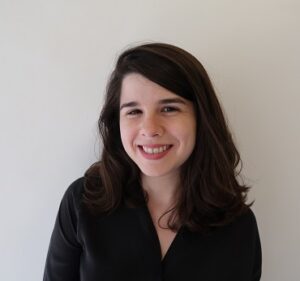By Carolina Meneses
Carolina Meneses is Dance/USA’s first Dance Archiving & Preservation Fellow. Her Fellowship, from July-September 2018, is hosted by UCLA Library Special Collections, and her practicum site is Lula Washington Dance Theatre. Read more about the Fellowship program here. This is the fifth of six posts from Carolina’s 2018 summer blog. Read the fourth part here, and the sixth part here.
November 13, 2018
“Elle Johnson’s story is a gap in the dance record of Los Angeles that deserves to be preserved and described for future researchers”
Before I attended SAA and started my practicum at Lula Washington Dance Theatre, I meant to post about a project I started at UCLA Library Special Collections (LSC). I was assigned to process a small collection, the Elle Johnson papers. This was a very exciting opportunity for me, since it was my first time processing a collection from start to finish.

Elle Johnson Dance Trio photos from the 1950s, Elle Johnson papers (Collection 2362). UCLA Library Special Collections, Charles E. Young Research Library, University of California, Los Angeles.
Though not as well known today as Ruth St. Denis, Elle Johnson was essential to LA’s young but rapidly growing dance scene in the 1950s. Elle first studied under Katherine Dunham and later Lester Horton before forming her own dance troupe, the Elle Johnson Trio with Bruce Bain and David Hebel. She was assistant choreographer for a number of 20th Century Fox films in the mid 1950s. Elle was also a popular dance teacher with Hollywood actors. Although Elle enjoyed performing with her troupe, she found the most satisfaction in teaching.
In 1966 Elle formed her own company, the Elle Johnson Dance Company, “with the objective of providing performing outlets for California dancers as well as a chance for choreographers to experiment” (from Performing Arts, The Music Center Monthly, March 1971, Vol. 5 No. 3). Many of the works Elle created included motifs of Afro-Cuban dance, as seen in Swadeski. Other original works like Soleus were more abstract and usually set to jazz music. Elle’s group performed throughout Los Angeles, from high schools to small theaters. Until she retired in 1999, Elle maintained a loyal following. I should mention that Genie Guerard (Curator and Manuscripts Librarian, and also my Dance/USA host for the fellowship) studied under Elle Johnson in the 1970s and 1980s.
It was hard to piece together Elle’s history, as there isn’t much information out there, save for her obituary and a mention in a Lester Horton’s biography. I relied mostly on the clippings that I found in her archive. Everything came in a small legal size document box and my first task was to create a basic survey of the materials, making note of dates and material formats. I observed that the materials were in no discernible order. I found mostly undated photographs, newspaper clippings, publications, programs, and fliers.

Elle Johnson Dance Company photos, circa 1966-1979, Elle Johnson papers (Collection 2362). UCLA Library Special Collections, Charles E. Young Research Library, University of California, Los Angeles.
Next, I created a processing plan. I worked out an appropriate processing level based on the collection’s research value, institutional value, and object value. Following the LSC processing manual as well as Guidelines for Efficient Archival Processing in the University of California Libraries, I decided it would be best to arrange the collection by file, sorted by material type alphabetically since there were no common themes in the intellectual content that I could find.
The bulk of the Elle Johnson papers consist of photographs. I separated these by format (photographs and negatives) chronologically by approximate decade and placed them in folders accordingly. After physically arranging the other materials, I began to write descriptions for the finding aid via ArchiveSpace. Unfortunately, I was not able to finish, but it is a project I will complete during my Mosaic internship at UCLA LSC, as Elle Johnson’s story is a gap in the dance record of Los Angeles that deserves to be preserved and described for future researchers.
 Carolina Meneses is pursuing a master’s degree in library and information science at UCLA, specializing in archival studies. A second generation Cuban-American from Miami, she received her BA in comparative literature at Smith College where she focused on the intersection of memory, dance, and language. After college, she participated in an archival internship with a dance company based in New York City, which became the foundation for her interest in the contradictory nature of preserving the ephemerality of dance performance for research and reproduction. Carolina is also the recipient of a Mosaic Scholarship from the Society of American Archivists, which provides support for minority students pursuing graduate studies in archival science.
Carolina Meneses is pursuing a master’s degree in library and information science at UCLA, specializing in archival studies. A second generation Cuban-American from Miami, she received her BA in comparative literature at Smith College where she focused on the intersection of memory, dance, and language. After college, she participated in an archival internship with a dance company based in New York City, which became the foundation for her interest in the contradictory nature of preserving the ephemerality of dance performance for research and reproduction. Carolina is also the recipient of a Mosaic Scholarship from the Society of American Archivists, which provides support for minority students pursuing graduate studies in archival science.
____
We accept submissions on topics relevant to the field: advocacy, artistic issues, arts policy, community building, development, employment, engagement, touring, and other topics that deal with the business of dance. We cannot publish criticism, single-company season announcements, and single-company or single artist profiles. Additionally, we welcome feedback on articles. If you have a topic that you would like to see addressed or feedback, please contact communications@danceusa.org.
Disclaimer: Opinions expressed in guest posts do not necessarily represent the viewpoints of Dance/USA.



